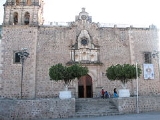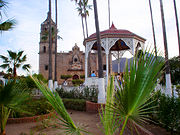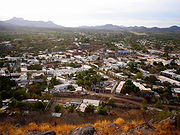
Álamos
Encyclopedia


States of Mexico
The United Mexican States is a federal republic formed by 32 federal entities .According to the Constitution of 1917, the states of the federation are free and sovereign. Each state has their own congress and constitution, while the Federal District has only limited autonomy with a local Congress...
of Sonora
Sonora
Sonora officially Estado Libre y Soberano de Sonora is one of the 31 states which, with the Federal District, comprise the 32 Federal Entities of Mexico. It is divided into 72 municipalities; the capital city is Hermosillo....
was founded in the late 17th century following discoveries of silver in the region. It was named by the conquistador
Conquistador
Conquistadors were Spanish soldiers, explorers, and adventurers who brought much of the Americas under the control of Spain in the 15th to 16th centuries, following Europe's discovery of the New World by Christopher Columbus in 1492...
Francisco Vásquez de Coronado
Francisco Vásquez de Coronado
Francisco Vásquez de Coronado y Luján was a Spanish conquistador, who visited New Mexico and other parts of what are now the southwestern United States between 1540 and 1542...
, and became the capital of the surrounding region. Alamos is the northern-most 'Silver City' in Mexico and although it has much in common, architecturally, with Mexico's other 'Silver Cities' it has not succumbed to large-scale commercialism and has managed to retain the charm and pace of earlier times. Many writers and artists have quietly claimed Alamos for their own.
Álamos is located in the southeastern part of Sonora
Sonora
Sonora officially Estado Libre y Soberano de Sonora is one of the 31 states which, with the Federal District, comprise the 32 Federal Entities of Mexico. It is divided into 72 municipalities; the capital city is Hermosillo....
, and 396 km (246.1 mi) from state capital Hermosillo
Hermosillo
Hermosillo is a city and municipality located centrally in the northwestern Mexican state of Sonora. It is the capital and main economic center for the state and region. It contains almost all of the state's manufacturing and has thirty percent of its population...
, 54 km (33.6 mi) from Navojoa
Navojoa
Navojoa is the fifth-largest city in the northern Mexican state of Sonora and is situated in the southern part of Sonora, south of the state's border with the U.S. state of Arizona. It is the administrative seat of a large municipality, located in the Mayo River Valley.-History:The city name...
via Sonora State Highway 162
Sonora State Highway 162
Sonora State Highway 162 is a highway in the south of the Mexican state of Sonora.It runs from Navojoa, where it is named Lázaro Cárdenas Boulevard, to the town of Álamos....
, and 663 km (412 mi) from the northern border town of Nogales
Nogales, Sonora
Heroica Nogales , more commonly known as Nogales, is a city and its surrounding municipality on the northern border of the Mexican State of Sonora. The municipality covers an area of 1,675 km², and borders to the north the city of Nogales, Arizona, United States, across the U.S.-Mexico border...
. It is adjoined by the State of Chihuahua on the east, and the State of Sinaloa on the south. The population of the municipality is 24,493 and its area 6,947.27 km². Average temperature is about 14 °C (58 °F); maximum 47 °C (117 °F).
Álamos is known as "La Ciudad de los Portales" (portales are tall, arched, covered verandas or walkways fronting many of the cobble-stoned streets or calles). Alamos boasts numerous buildings exhibiting classic architecture from Mexico's Colonial period, including the Plaza de Armas, the Church of La Purísima Concepción, La Capilla and the Palacio Municipal ("city hall"). The great wealth created by the silver mines from the surrounding mining towns of La Aduana, Minas Nuevas and San Bernardo enabled the founders and residents of Alamos to build scores of colonial Spanish mansions throughout the town; most of which were destroyed in the early 20th Century, and replaced by the images of what Americans who had bought the ruins thought the colonial princes wanted as homes. Although attractive there is little original or accurate there today of the colonial period.
The economy of Alamos has long been depressed, contributing in large to the exodus of population and business. Nevertheless, in recent years much interest has developed in "birding." and many enthusiasts visit annually. True industry in the form of copper and silver mining have developed in the past three years in predominantly two areas, silver mining in the Cerro Colorado region to the south of Alamos and copper mining in the Piedras Verdes location to Northwest. The Sierra de Alamos Ecological Reserve, offers serious 'birding' opportunities. About 16 km to the West is the Adolfo Ruiz Cortinez Dam and Reservoir known as “El Mocúzarit”, whose waters irrigate 80000 acres (323.7 km²). Cattle ranching is seasonal and declining due to impoverished grazing lands. Numerous chicken and pig farms, called "granjas," contribute substantially to the economy.
Many Festivals and fiestas occur in Álamos year-round, most notably the Festival of Dr. Alfonso Ortiz Tirado ("FAOT"), attended by many national and international musicians, and celebrities. Dr. Alfonso Ortiz Tirado
Alfonso Ortiz Tirado
Alfonso Ortiz Tirado was an opera singer and doctor born in Álamos, Sonora, Mexico in 1893. His musical talent was apparent early in life, but he studied at the Escuela Nacional Preparatoria and university to become a doctor. He specialized in gynecology as well as general medicine, and eventually...
, born in this community in 1894, achieved recognition for being "El Tenor de las Américas." An impressive exhibit of Ortiz Tirado is found in the Museo Costumbrista, located in front of and to the east of the Plaza de Armas. The annual Festival Alfonso Ortiz Tirado is a nine day event that takes places in Alamos annually in late January.
The first President of Modern Mexico---post Mexican Revolution---Alvaro Obregon was born on a farm near Alamos on February 17, 1880.
The renowned Mexican screen actress, María Félix, was also born near Alamos on a farm in Quiriego onApril 8, 1914.
The creek of Cuchujaqui, which is in the ecological reserve is the most subtropical area in the Northern Hemisphere. Cuchujaqui is the subject of international scientific study and the southern migration destination of hundreds of different species of birds.
,
Álamos was named a "Pueblo Mágico
Pueblo Mágico
The Programa Pueblos Mágicos is an initiative led by Mexico's Secretariat of Tourism , in conjunction with other federal and state agencies, to promote a series of towns around the country that offer visitors a "magical" experience – by reason of their natural beauty, cultural riches, or...
" in 2005. "Pueblo Magico" is a designation given by the Mexican Secretariat of Tourism to towns that offer a 'magical' experience by reason of their natural beauty, cultural riches and historical relevance.
Nearby, in the small town of La Aduana is the "Mexican jumping bean ("brincadores") capital of the world."
Coordinates: 27°1'N 108°5'
Famous people born in Álamos
- María FélixMaría FélixMaría Félix was a Mexican film actress and one of the icons of the golden era of the Cinema of Mexico and also one of the myths of the Spanish language Cinema for her life style and personality...
, motion pictureFilmA film, also called a movie or motion picture, is a series of still or moving images. It is produced by recording photographic images with cameras, or by creating images using animation techniques or visual effects...
actress - Félix María ZuloagaFélix María ZuloagaFélix María Zuloaga Trillo was a Mexican general and a Conservative leader in the War of Reform. In the late 1850s and early 1860s, Zuloaga served as unconstitutional interim conservative president of Mexico .-Early years:Zuloaga was born in Álamos, Sonora...
, soldier, politicianPolitics of MexicoThe politics of Mexico take place in a framework of a federal presidential representative democratic republic whose government is based on a congressional system, whereby the president of Mexico is both head of state and head of government, and of a multi-party system...
, President of MexicoPresident of MexicoThe President of the United Mexican States is the head of state and government of Mexico. Under the Constitution, the president is also the Supreme Commander of the Mexican armed forces... - Arturo MárquezArturo MárquezArturo Márquez is a renowned Mexican composer of orchestra music who is well known for using musical forms and styles of his native Mexico and incorporating them into his compositions.-Life:...
, composerComposerA composer is a person who creates music, either by musical notation or oral tradition, for interpretation and performance, or through direct manipulation of sonic material through electronic media... - Alfonso Ortiz TiradoAlfonso Ortiz TiradoAlfonso Ortiz Tirado was an opera singer and doctor born in Álamos, Sonora, Mexico in 1893. His musical talent was apparent early in life, but he studied at the Escuela Nacional Preparatoria and university to become a doctor. He specialized in gynecology as well as general medicine, and eventually...
, Physician, Tenor and Philanthropist - Joaquin MurrietaJoaquin MurrietaJoaquin Carrillo Murrieta , also called the Mexican or Chilean Robin Hood or the Robin Hood of El Dorado, was a semi-legendary figure in California during the California Gold Rush of the 1850s...
(ca.1829-1853?), CaliforniaCaliforniaCalifornia is a state located on the West Coast of the United States. It is by far the most populous U.S. state, and the third-largest by land area...
bandit; however, QuillotaQuillotaQuillota is a city and commune located in the Aconcagua River valley of central Chile's Valparaíso Region. It is the capital and largest city of the Quillota Province where many inhabitants live in the surrounding farm areas of San Isidro, La Palma, Pocochay, and San Pedro...
, ChileChileChile ,officially the Republic of Chile , is a country in South America occupying a long, narrow coastal strip between the Andes mountains to the east and the Pacific Ocean to the west. It borders Peru to the north, Bolivia to the northeast, Argentina to the east, and the Drake Passage in the far...
, also claims him as a native son.

